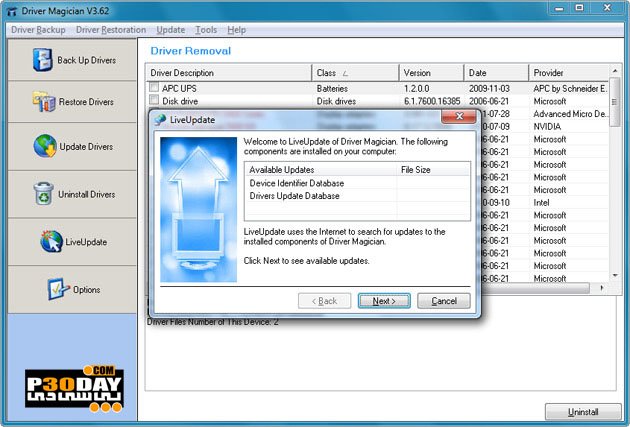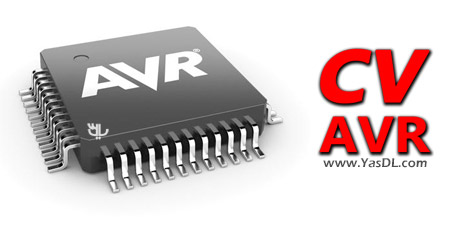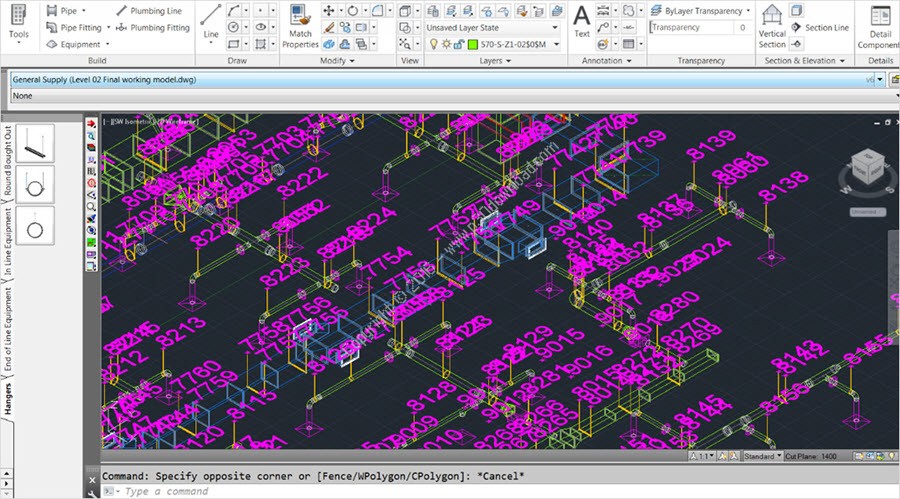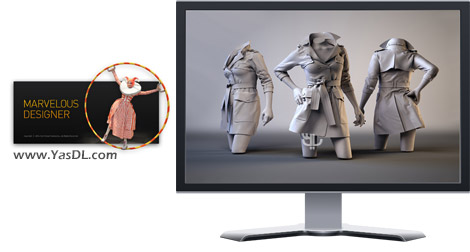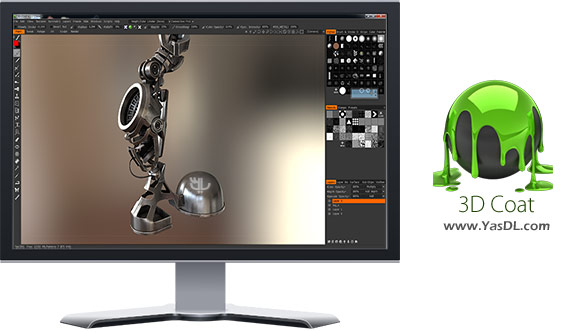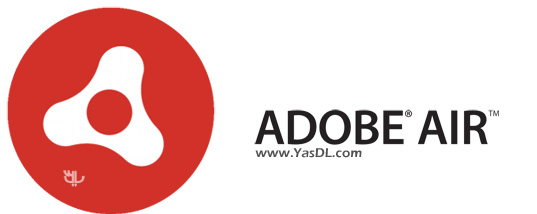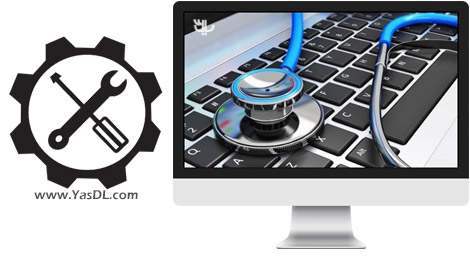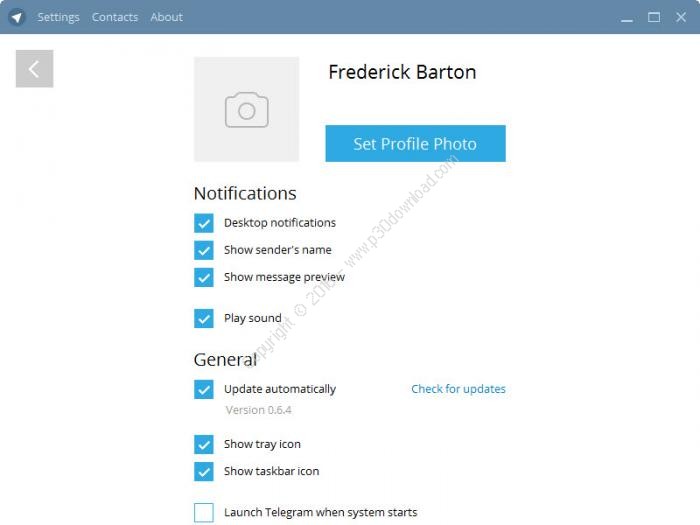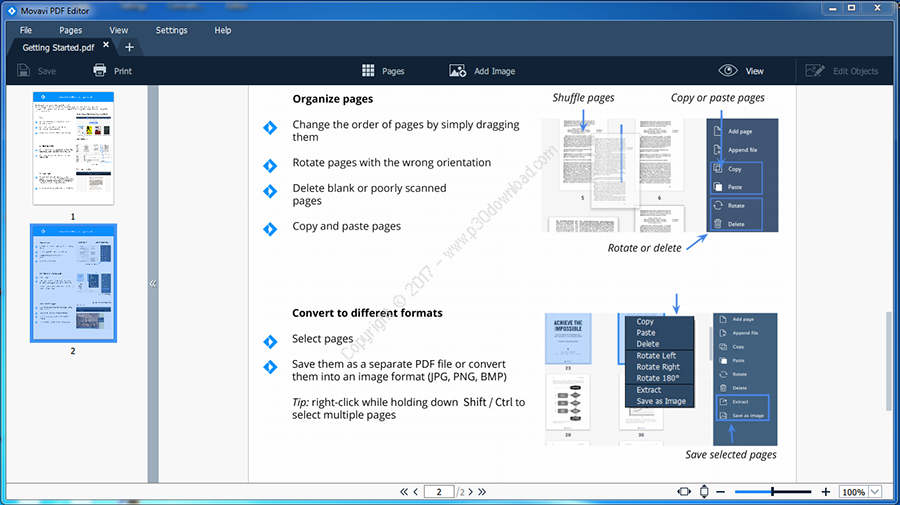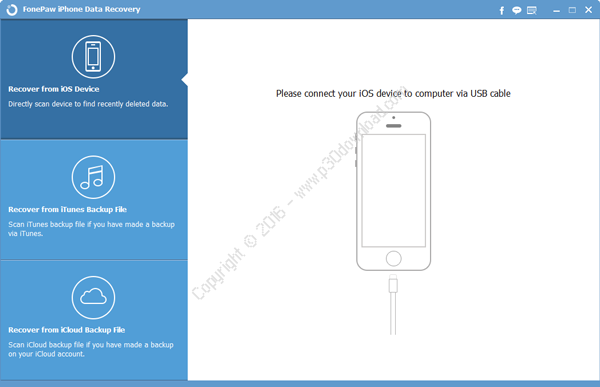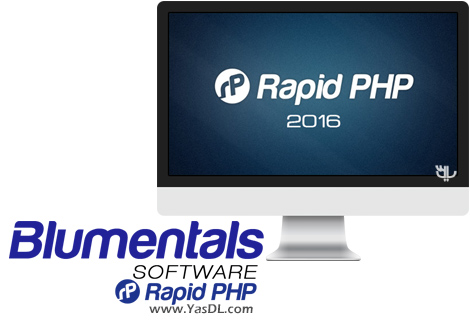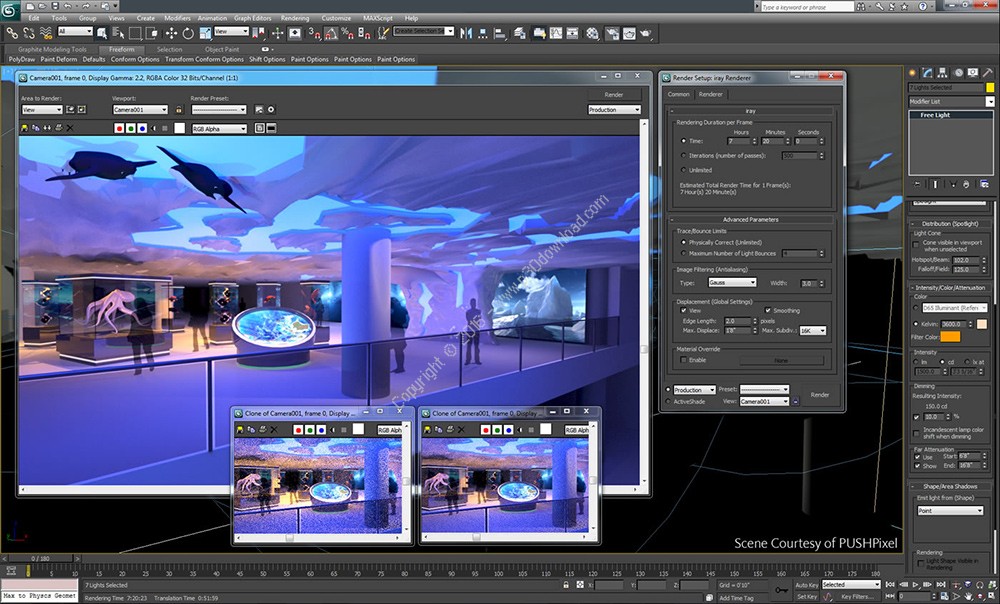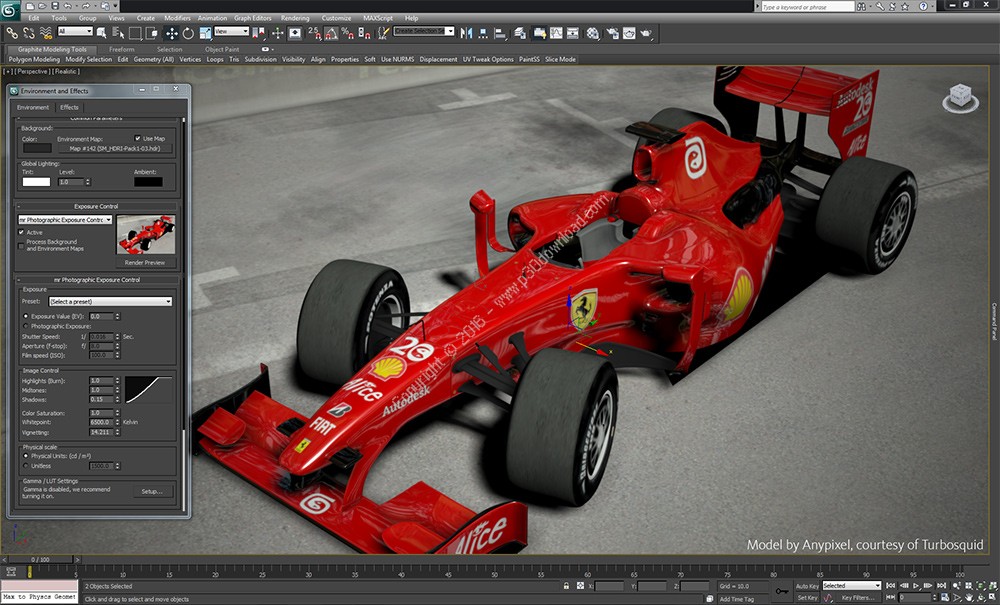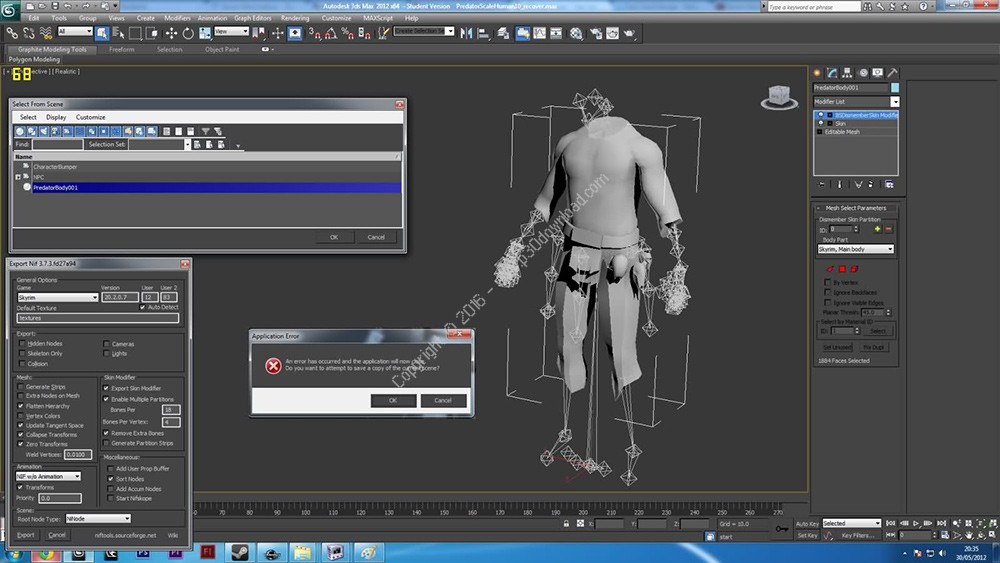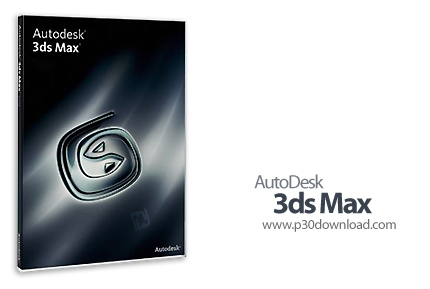Create rich and complex design visualization. Generate realisticcharacters for a top-selling game. Bring 3D effects to the bigscreen.
Autodesk 3ds Max supports 3D modeling, animation,and rendering software helps design visualization professionals,game developers, and visual effects artists maximize theirproductivity by streamlining the process of working with complexscenes.
Viewing and Handling of Large, ComplexScenes
3ds Max software delivers new viewport technology and optimizationsthat result in vastly improved interactivity of even the largest,most complex scenes. Common tasks and operations-selection,material assignment, transform, grouping, cloning, and manymore-are now significantly faster, making 3ds Max the moststreamlined version of the software ever. Plus, a new SceneExplorer makes managing large scenes-and interacting with hundredsor even thousands of objects-far more intuitive.
Review Rendering
Produce stunning photo-real imagery, faster. With the release of3ds Max, Autodesk unveils Review. This powerful new toolsetsupports iterative rendering workflows by delivering interactivepreviewing of shadows, the 3ds Max sun/sky environment, and mentalray Architectural and Design material settings. Based on the latestgame engine technology, Review gives you the instant visualfeedback you need to iterate rapidly.
Support for Complex Pipelines and Workflows
Quickly extend 3ds Max or streamline multi-application workflows.The new MAXScript ProEditor provides you with an intuitiveinterface for working with MAXScript that will streamline thescripting workflow, making it easier to author scripts thatautomate and customize 3ds Max. Deeper support for the DWG and FBXfile formats results in faster, more accurate importing of datafrom other popular Autodesk applications; plus, new featuresfacilitate working with this imported data.
Artist-Friendly Modeling
Enjoy a less menu-dependent modeling experience. 3ds Max gives youa more streamlined, artist-friendly modeling workflow through acollection of hands-on modeling UI options that let you focus moreon the creative process.
Here are some key features:
3ds Max User Interface:
– Gain unmatched productivity through a combination of performanceand workflow features, including a fast, high-quality viewportenvironment, schematic view, multiple coordinate systems,interactive axis constraints, customizable menus and buttons,viewport grips/manipulators, and modeless keyboard entry. Achieveefficiency through streamlined workflows, custom hotkeys andcross-application navigation tools like ViewCube and SteeringWheelsfunctionality.
– Use the unique modifier stack for a visual, parametric workflow;any change made in the modifier stack is automatically propagatedto the end result. Work nonlinearly on a completed high-resolutioncharacter model; revert to the original low-resolution geometry atthe bottom of the stack and add details, such as buttons on a shirtor tweaks to the nose. Those changes pass through finishingmodifiers (such as smoothing, mapping, and skinning) to appear inthe completed character.
– Use a mouse or tablet-based paintbrush interface for objectselection and deformation, vertex color, and radiositytouch-up.
Data and Scene Management:
– Facilitate the use and transfer of 3ds Max data among fileiterations, users, and locations with file management utilities,including project folders, relative paths, repathing tools, assettracking, Containers, increment on save, auto-backup, resourcecollector, dynamic texture reloading, and log files.
– Use the Scene Explorer Panel to sort, filter, and search a sceneby any object type or property (including metadata) with stackablefiltering, sorting, and searching criteria. Save and store multipleexplorer instances and link, unlink, rename, hide, freeze, anddelete objects regardless of the objects currently selected in thescene. Configure columns to display and edit any object property—afeature that can be extended using MAXScript.
– Manage complex scenes and animations with an intelligent externalfile-referencing feature for scenes, objects, or materials.
– Work in layers using the Layer Manager to quickly isolate relatedscene elements.
– Manage source controls for in-use assets with Asset Tracker, afeature tightly integrated with Autodesk Vault data-managementsoftware and compatible with most third-party data-managementsolutions.
·- Transfer building information models from Autodesk RevitArchitecture building design software into 3ds Max with theRecognize scene-loading technology. Use Material Explorer tonavigate and manage all rendering-related assets in a scene.
– The addition of the Containers toolset to 3ds Max facilitatescollaboration and flexible workflows by enabling users to collectmultiple objects into a single container when dealing with complexscenes.
Modeling:
– Choose from ready-to-use geometry, including standard andextended primitives; 2D shapes; and architectural elements, such asdoors, windows, and stairs.
– Create models quickly and efficiently with the new Graphitemodeling toolset. Graphite takes 3ds Max polygon modeling to a newlevel by delivering over 100 tools for advanced polygonal modelingand freeform design.
– Create compound objects using the Scatter, Connect, Booleans,ShapeMerge, Morph, BlobMesh, Terrain, and Loft operations.
– Convert parametric and compound objects to base geometrictypes―editable mesh, editable poly, editable patch, or NURBSobjects―for more detailed editing.
– Use 2D shapes as a starting point for creating editable splinesand spline cages to convert to any 3D geometry type.
Polygon Modeling and Texturing:
– Use the polygon/tri-mesh architecture to create, edit, andtexture mesh models. These models can contain color-per-vertex,mapping, and selection channels and explicit normals, all of whichcan be animated in the modifier stack.
Polygon Modeling Tools:
– Employ creation and editing tools, including create, collapse,attach, bridge, flip, hinge from edge, turn, cut, split, slice,quick slice, wedge, bevel, extrude, chamfer vertex, extrude along acurve, mirror, edge loop, and edge ring.
– Use ProBooleans to reevaluate and optimize the topology ofmeshes. Quickly fracture geometry into smaller, individual chunkswith the ProCutter tool.
– Choose from workflow features, including the Graphite modelingtoolset; Preserve UVs, which separate texture coordinates from thepolygon vertices to edit the mesh without destroying UV data;subobject selection sets (vertices, edges, and faces), whichintelligently convert between different types of selections (edgesto vertices); interactive previewing of edits and animated edits;and the ability to change modeling hotkeys and pivots to temporaryoverrides.
– Use a large range of modeling modifiers to work with geometry andsubobject geometry in the modifier stack, including Projection,Edit Normals, Vertex Paint, and those that let you bend, bevel, capholes, cross section, displace, extrude, and subdividepolygons.
Texture Assignment/Editing:
– Paint directly on 3D models in the viewport to create new maps orextend existing ones using brushes, blend modes, fill, clone, anderase.
– Access the streamlined texture workflow for a material/mapbrowser with support for drag-and-drop assignment and hierarchieswith thumbnails, and to combine an unlimited number oftextures.
– Use UV workflow features including Pelt mapping, which definescustom seams and enables users to unfold UVs according to thoseseams; copy and paste (of materials, maps, and colors); andquick-mapping (box, cylindrical, and spherical).
– Use up to 99 UV sets for texture layering.
– Use extensive UVW mapping tools to directly manipulate texturemapping coordinates.
– Work in the modifier stack with texture modifiers, includingCamera Map, Material Modifier, UVW mapping modifiers, UV Xform, MapScaler, and Surface Mapper.
– Use the xView Mesh Analyzer to test or query for flipped oroverlapping faces, unwelded vertices, missing maps, and object andMaterial IDs.
– Navigate and manage all rendering-related assets in a scene withthe Material Editor.
Spline/Extended Spline Modeling:
– Attach, detach, align, stitch together, extend, fillet, orrebuild surfaces with a high degree of control overparameterization and continuity.
– Deform, lathe, normalize spline, set spline render properties,sweep, and trim/extend with spline modifiers when modeling with themodifier stack.
– Choose from a range of modifiers for direct manipulation ofsubobject geometry, such as Curve CV, Surface CV, and surface.
General Keyframing:
– Two keying modes—set key and auto key—offer support for differentkeyframing workflows.
– Fast and intuitive controls for keyframing including cut, copy,and paste, let the user create animations with ease.
– Animation trajectories can be viewed and edited directly in theviewport.
Animation Controllers:
– A wide range of controllers, both key-based and parametric, maybe used to animate the full transform or the position, rotation, orscale of objects.
– Key-based controllers, such as Bézier and TCB, store values andinterpolation methods in each key, which can be edited with thosecontrols.
Constrained Animation:
– Animate objects along curves with controls for alignment,banking, velocity, smoothness, and looping, and along surfaces withcontrols for alignment. Weight path-controlled animation betweenmultiple curves and animate the weight.
– Constrain objects to animate with other objects in manyways—including look at, orientation in different coordinate spaces,and linking at different points in time. These constraints alsosupport animated weighting between more than one target.
– Collapse all resulting constrained animation into standardkeyframes for further editing.
Procedural Animation:
– Parametric controllers unique to each controller type storevalues that affect the animation throughout.
– Users can create procedural animation based on numerous built-incontrollers including noise, expressions, waveform, spring, andaudio. All resulting procedural animation can be collapsed intostandard keyframes for further editing.
Script and Expression Controllers:
– Use custom controllers as scripts and expressions.
– Control the animation by any math function as well as by anyMAXScript using expressions.
– Control the animation by any relationship describable usingMAXScript with scripted controllers.
– Collapse all resulting script or expression-based animation intostandard keyframes for further editing.
List Controllers:
– Blend multiple animation tracks into a single result using ahierarchy of controllers in a list.
– Use list controllers to store different poses and versions ofanimation on the same object or objects.
– Weight and animate the influence of each controller in the listover time.
Reaction Controllers:
– Set up reactions to make objects respond to the animation ofother objects.
– Set up and trigger states for reactions with desired values sothe reacting object will be controlled without having to be keyedby hand.
Parameter Wiring:
– Wire together one- and two-way relationships between controllersto offer a more custom method of keying animation.
– Implement custom animation controls by wiring UI elements such assliders and spinners to an object’s animatable tracks.
– Control multiple attributes with a single slider.
Track View: Curve Editor and Dope Sheet:
– Edit keyframe animation track by track using curves along thetimeline to more easily visualize the components of theinterpolation. Tools for editing curves include limiting, curvedrawing, and curve modifiers.
– Use the Dope Sheet to edit keys individually or in groups andranges.
– Slide, move, and scale keys or sets of keys in both time andvalue.
– Edit animation track by track by copying, pasting, and instancingcontrollers.
– Use Track Sets to organize complex animation into discreteentities for easier editing.
– Precisely control dense animation using soft selection falloffand Reduced Keys that maintain the integrity of the originalanimation.
– Load sound tracks into Track View for easy synchronization withtarget animation.
– View animation before and after the current frame to evaluateobject motion.
Modifier Animation:
– Use the Point Cache modifier to save and load surfacedeformations for easy swapping and fast playback.
– Use the Morpher modifier as an interface for organizing andanimating morphing targets and for progressive morphingsupport.
Skinning:
– Use either the Skin or Physique modifier to achieve precise,smooth control of skeletal deformation as joints are moved, even inchallenging areas, such as shoulders.
– Control skin deformation using direct vertex weights, volumes ofvertices defined by envelopes, or both.
– Use capabilities such as weight tables, paintable weights, andsaving and loading of weights for easy editing and proximity-basedtransfer between models, providing the accuracy and flexibilityneeded for complicated characters.
– Apply the rigid bind skinning option to animate low-polygonmodels or as a diagnostic tool for regular skeleton animation.
– Use additional modifiers, such as Skin Wrap and Skin Morph, todrive meshes with other meshes and make targeted weightingadjustments in tricky areas.
Setup+Crack Size: 3817 MB
Download Links > Autodesk 3ds Max 2012 SP2 Update12 x86/x64 + Sample Files + Crack
